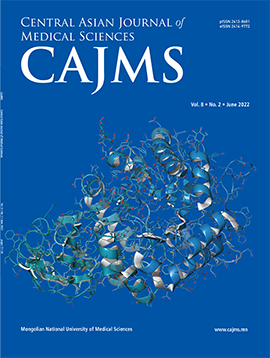Prevalence of Blood-Borne Infection Among Healthcare Workers
DOI:
https://doi.org/10.24079/cajms.2021.12.006Keywords:
Blood-Borne, Infection, Hepatitis, Prevalence, Healthcare WorkersAbstract
Objectives: Needlestick and sharps injuries are a major cause of transmission of blood borne pathogens in health-care workers. The present study aims to examine the yearly incidence and causes of sharps injuries and assess the prevalence of blood-borne infection in provincial healthcare workers in Mongolia. Methods: A cross-sectional study enrolling 21 province hospitals across Mongolia was conducted from 2015 to 2019. Descriptive data presented as absolute numbers with percentage and a multivariate analysis was employed to identify the association between risk factors and occupational exposure to blood-borne factors. Results: Of the 20546 health care workers, 12.5% (n = 2566) employees were infected with hepatitis. Approximately 4.4% were infected with hepatitis B; 7.5% with hepatitis C; and 0.6% with hepatitis B, C or B, D. Among health care workers detected with hospital-acquired infection, most were women (n = 84.1%), aged between 41-55 years old (58.9%). Having sharp needlestick injuries, blood and body liquids splash, and a dental service was found to be associated with hospital-acquire infection in the study. Conclusion: Our study results demonstrated that 12 out of 100 health care workers were infected with HAI in Mongolia. This indicates that there be might serious occupational hazards. Public health authorities should consider increasing provision of public health programs such as vaccination, safety equipment and adjusted workload. Health care workers in Mongolia should be informed about the risks and consequences, as well as undertake preventive measures.
Downloads
281
Downloads
Published
How to Cite
Issue
Section
License
Copyright (c) 2021 Mongolian National University of Medical Sciences

This work is licensed under a Creative Commons Attribution-NonCommercial 4.0 International License.




